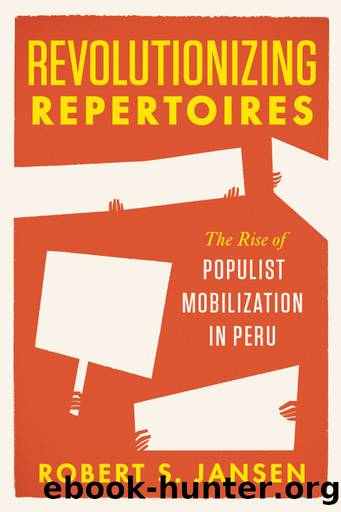Revolutionizing Repertoires by Robert S. Jansen

Author:Robert S. Jansen [Jansen, Robert S.]
Language: eng
Format: epub
Tags: Social Science, General, Sociology, Political Science, History & Theory, History, Latin America, South America
ISBN: 9780226487588
Google: Cb4zDwAAQBAJ
Publisher: University of Chicago Press
Published: 2017-10-17T05:50:34+00:00
4
The Sources of Political Innovation
Habit, Experience, and Deliberation
By May 1931, Peruvian political actors were facing an unprecedented situation. A democratically oriented military junta had created a political opening that introduced a historically unique set of political rules and electoral realities; the political field had undergone dramatic transformations in a relatively short period of time; and profound changes in economic, infrastructural, and social conditions had produced novel challenges and opportunities for political action. But while it might be reasonable to expect that these socio-political realities would have encouraged some measure of political adaptationâand even of popular-oriented political experimentationâin the run-up to the 1931 election, the existence of these realities cannot explain which actors would take steps toward innovation (and which would not), let alone what their new political practices would look like. That is, even at this late stage in the game, the socio-political realities did not render the historical emergence of populist mobilization inevitable.
All Peruvian political actors, regardless of their characteristics, faced the same configuration of social and political conditions going into the election. But these actors understood and responded to the conditions differently in the first few months of campaigning. These early differences were highly consequential. By late July, the leadership circles around both Haya de la Torre and Sánchez Cerro were pursuing increasingly innovative lines of political action that were taking on the characteristics of populist mobilization. But other political actorsâto both the left and the right of Haya and Sánchez Cerroâreacted differently. Most elite actors continued to machinate in ways consistent with the traditional practice of politics under the Aristocratic Republic. And on the opposite end of the political continuum, the Partido Comunista advocated an increasingly militant insurrectionary strategy. Neither the elites nor the Communists broke with their regular habits to innovate, even though they faced the same socio-political realities as the proto-parties that were forming around Haya and Sánchez Cerro. What explains this variation among the collective actors? And among those who did innovate, why did the practices that they developed come to look as they did and not otherwise?
I have already argued that the leadership networks gathering around Haya de la Torre and Sánchez Cerro were in positions that might prime them to innovate. But this does not explain why and how they did. Explaining this outcome requires a more detailed analysis of how these collective political actors experienced, understood, and responded to the social and political realities changing around them. Across all of the organized political actors in the field at the time, variation in their internal decision-making environmentsâand in the experience and worldviews of their leadershipâled to differences in whether the objective political opportunity was read as a problem situation in a way that would create an impetus to break with previous habits; and these same considerations led to variation in the sorts of actions that these organizations began to practice.
Unlike the elites and Communists, the leadership around both Haya and Sánchez Cerro experienced the situation as problematic. As this chapter will show,
Download
This site does not store any files on its server. We only index and link to content provided by other sites. Please contact the content providers to delete copyright contents if any and email us, we'll remove relevant links or contents immediately.
Cat's cradle by Kurt Vonnegut(15182)
Pimp by Iceberg Slim(14393)
4 3 2 1: A Novel by Paul Auster(12281)
Underground: A Human History of the Worlds Beneath Our Feet by Will Hunt(12022)
The Radium Girls by Kate Moore(11921)
Wiseguy by Nicholas Pileggi(5671)
Perfect Rhythm by Jae(5324)
American History Stories, Volume III (Yesterday's Classics) by Pratt Mara L(5256)
The Fire Next Time by James Baldwin(5248)
Paper Towns by Green John(5087)
Pale Blue Dot by Carl Sagan(4909)
A Higher Loyalty: Truth, Lies, and Leadership by James Comey(4843)
The Mayflower and the Pilgrims' New World by Nathaniel Philbrick(4421)
The Doomsday Machine by Daniel Ellsberg(4415)
Killers of the Flower Moon: The Osage Murders and the Birth of the FBI by David Grann(4385)
The Sympathizer by Viet Thanh Nguyen(4305)
Too Much and Not the Mood by Durga Chew-Bose(4271)
The Borden Murders by Sarah Miller(4247)
Sticky Fingers by Joe Hagan(4100)
